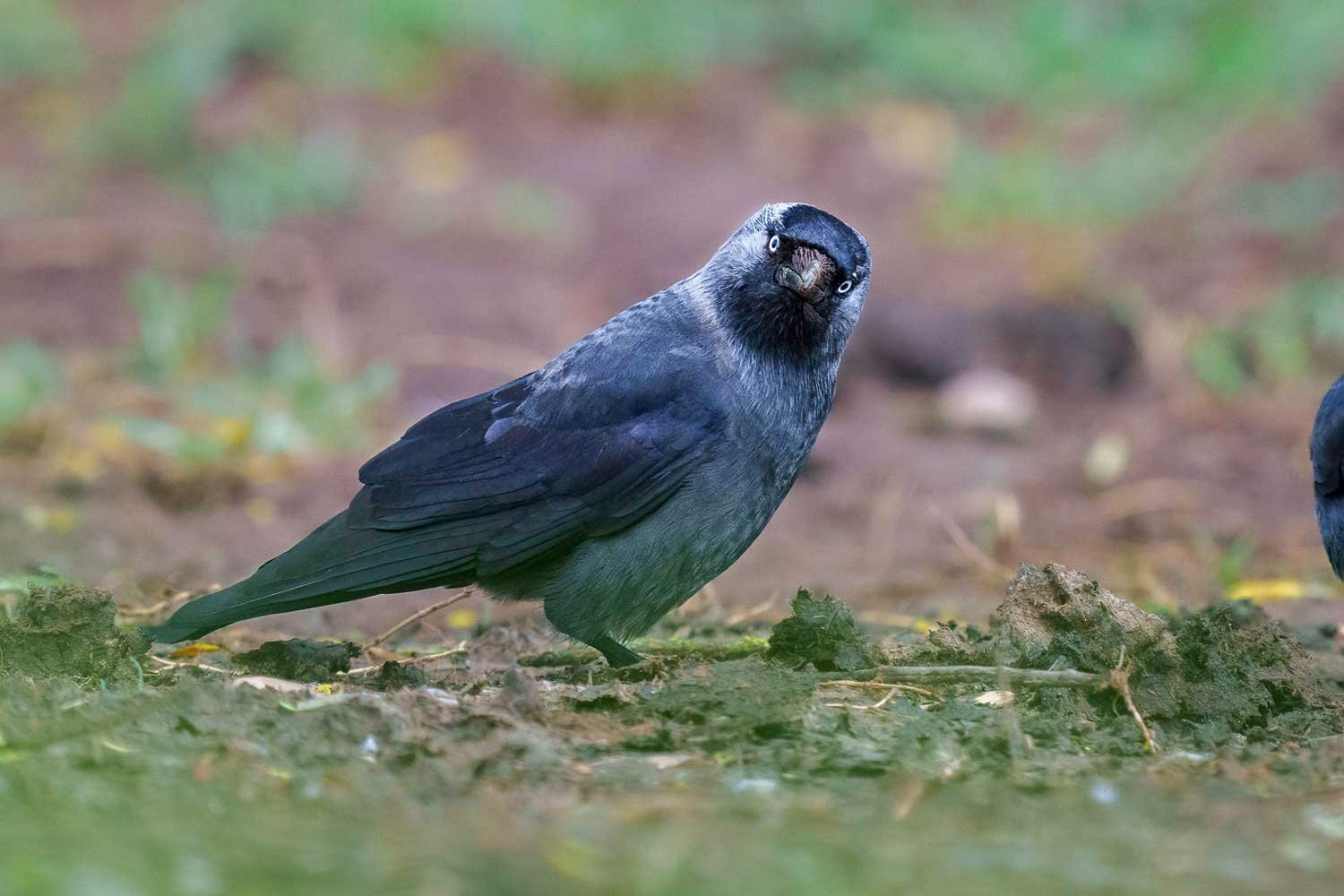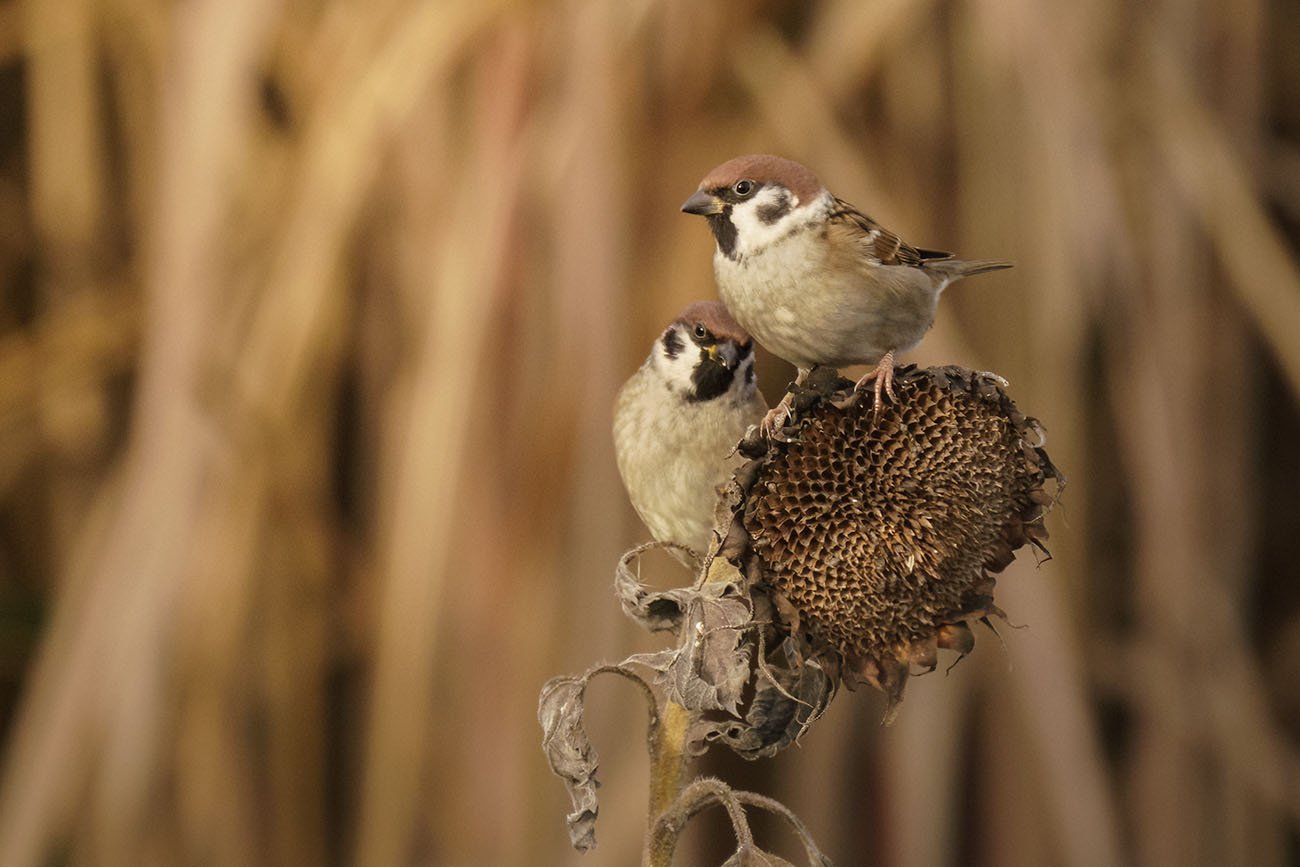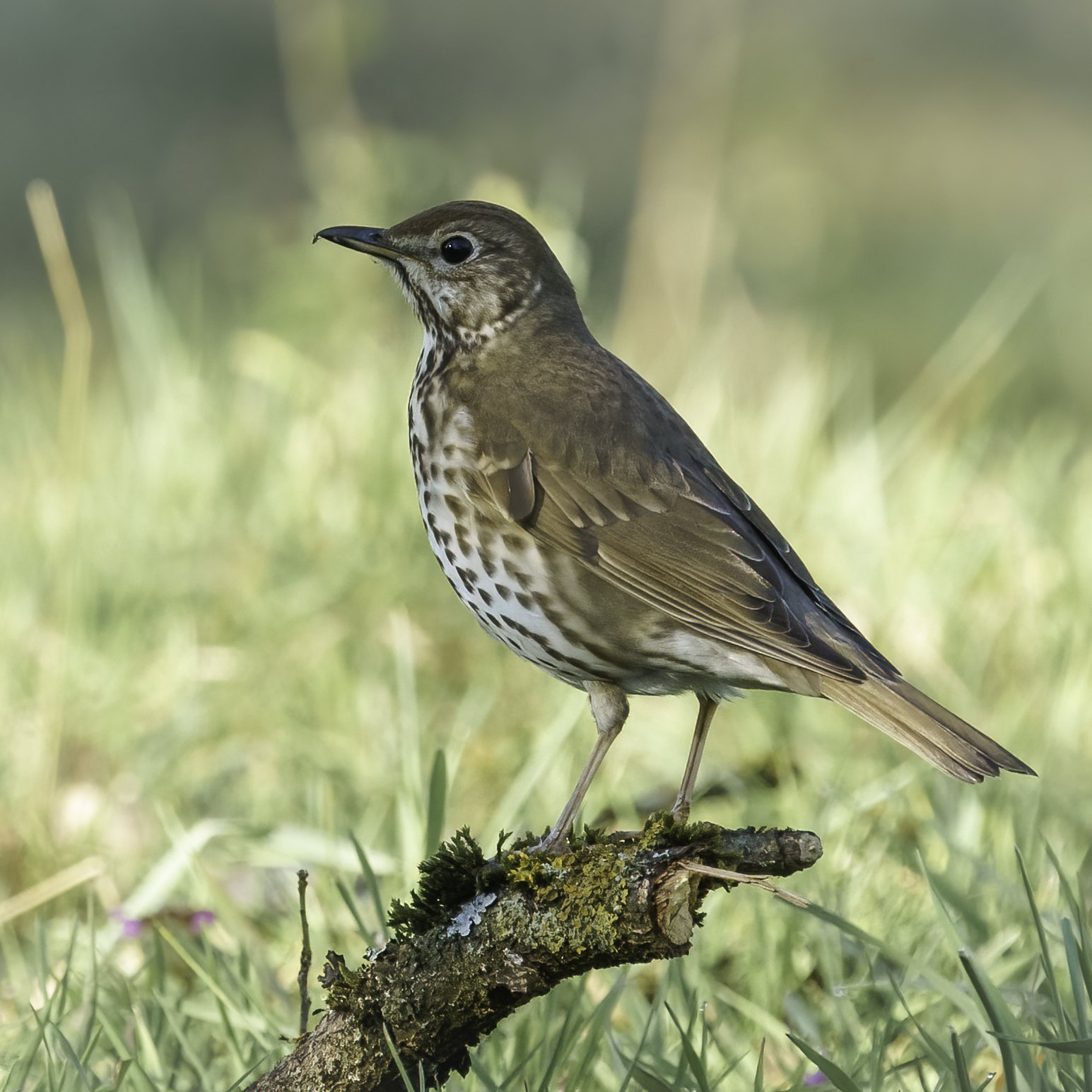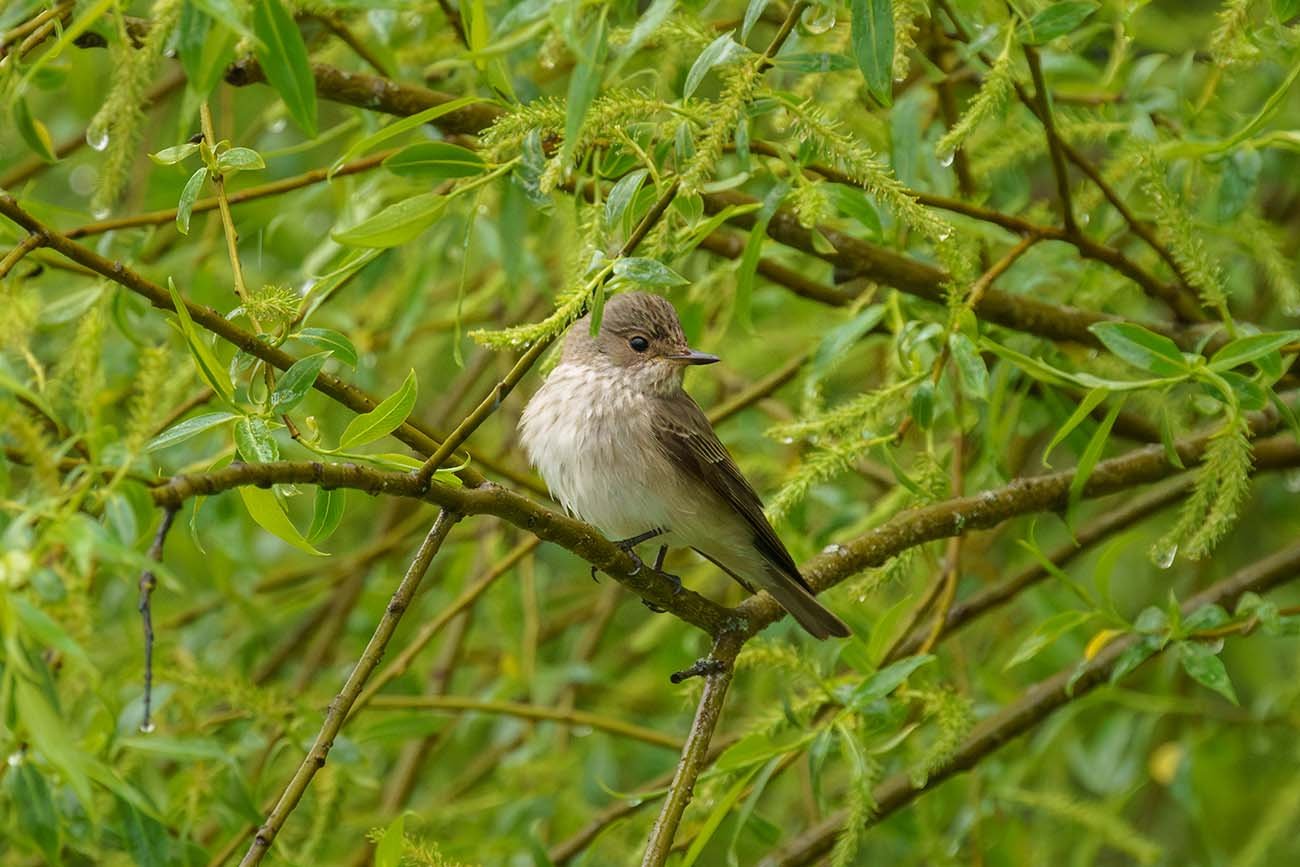Native Birds of Germany
Native birds are all wild birds that breed and raise their offspring in Germany. Depending on whether the bird species migrates south in the autumn or stays throughout the year, they are classified as migratory birds or resident birds.
The following list includes some of the most common bird species in Germany, found in various habitats. I will continuously expand this list and try to record both my previous sightings and those to come.
European Bee-eater (Merops apiaster)
The European Bee-eater (Merops apiaster) is a colorful bird that also breeds in some regions of Germany, such as Rhineland-Palatinate, Baden-Württemberg, Saxony, or Bavaria. It primarily feeds on insects, which it skillfully catches in flight. This species is distinguished by its brightly colored plumage, which features a combination of green, blue, yellow, and red hues. With a body length of about 25 to 29 centimeters and a wingspan of 36 to 40 centimeters, it is considered a medium-sized bird species.
Common Blackbird (Turdus merula)
The Common Blackbird (Turdus merula) is one of the most well-known birds in Germany and is often found in gardens and parks. The males have a distinctive black plumage with a yellow beak, while the females are brown. They have a beautiful singing voice and are active even in winter. Sometimes nature also has interesting variations in store that do not conform to the familiar image of the blackbird. As seen in the picture here, a male blackbird with white spots.
White Wagtail (Motacilla alba)
The White Wagtail (Motacilla alba) is a pretty black-and-white bird with a long tail. It is often found near water and has a characteristic, bobbing walk.
Blue Tit (Cyanistes caeruleus)
The Blue Tit (Cyanistes caeruleus) is a small, attractive tit with blue plumage on its back. It is often found in gardens and parks and feeds on insects and seeds.
Experience the masters of dive hunting in Germany!
Have you ever heard of the stunning ospreys in Germany? Dive into an exclusive video from Bavaria and experience their spectacular hunting up close!
Click here for the video ->->
Chaffinch (Fringilla coelebs)
The Chaffinch (Fringilla coelebs) is a common bird in forests and gardens in Germany. The male has a striking, pinkish breast plumage and a distinctive song. The females are more subtly colored.
Middle spotted woodpecker (Leiopicus medius, Syn.: Dendrocoptes medius)
The Middle Spotted Woodpecker (Leiopicus medius, Syn.: Dendrocoptes medius) is usually a less common sight. It is distinguished by its unmistakable red crown and differs from the similar Great Spotted Woodpecker by the absence of black stripes on its face. The Middle Spotted Woodpecker prefers to search for insects and larvae on old and dead trees, pecking at the bark with its less powerful beak.
The Great Spotted Woodpecker (Dendrocopos major) is a common sight in forests and parks. It has distinctive red plumage on its head and pecks holes in trees with its powerful beak to find food or create nesting sites.
Whinchat (Saxicola rubetra)
The Whinchat (Saxicola rubetra) is a small songbird commonly found in open landscapes such as meadows and moors. It is characterized by its distinctive orange-brown throat and light eyebrow stripe. In spring and summer, it is often seen perched on fence posts or shrubs, from where it hunts insects.
Western jackdaw (Corvus monedula)
The German Western jackdaw (Corvus monedula) is a black-gray crow with a distinctive white patch on its neck. It is often found in large groups and builds its nests in tree hollows or on buildings.
Eurasian Jay (Garrulus glandarius)
The Eurasian Jay (Garrulus glandarius) is a striking bird with a beige and brown plumage and blue feather patches on the wings, along with a distinctive feather crest on its head. It is commonly found in forests and feeds on acorns and other nuts.
Eurasian Siskin (Spinus spinus)
The Eurasian Siskin (Spinus spinus) is a small songbird frequently found in alder and birch forests, as well as in parks and gardens. It is easily recognizable by its bright yellow-green plumage with black wings and a black-streaked back. Males also have a distinctive black cap on their heads. In winter, Eurasian Siskins often form large flocks that forage for food together.
Eurasian magpie (Pica pica)
The Eurasian magpie (Pica pica) is a black-and-white crow with a long tail. It is often found near human settlements and feeds on a variety of foods, including insects and scraps.
Eurasian Tree Sparrow (Passer montanus)
The Eurasian Tree Sparrow (Passer montanus) is a small, brown bird with a distinctive black spot on its chest. It is often found near buildings and in city parks.
Willow warbler (Phylloscopus trochilus)
The Willow Warbler (Phylloscopus trochilus) is a small bird colored green and yellow with a distinctive song. It is often found in forests and parks and feeds on insects.
Short-toed Treecreeper (Certhia brachydactyla)
The Short-toed Treecreeper (Certhia brachydactyla) is a small bird with brown plumage and characteristic climbing behavior. It is often found in forests and parks and feeds on insects.
The garden warbler (Sylvia borin) is a grey-brown bird with a distinctive song. It is often found in gardens and parks and feeds on insects.
The common redstart (Phoenicurus phoenicurus) is a small, colorful bird with red plumage on its tail and chest. It is often found in gardens and parks and feeds on insects.
Bullfinch (Pyrrhula pyrrhula)
The bullfinch (Pyrrhula pyrrhula) is a striking bird with red plumage on its chest and a distinctive black cap. It is often found in forests and gardens and feeds on seeds.
The European serin (Serinus serinus) is a small, yellow bird with a distinctive green stripe on its wings. It is often found in gardens and parks and feeds on seeds.
The yellowhammer (Emberiza citrinella) is a pretty, yellowish-brown bird with a distinctive song. It is often found in fields and meadows and feeds on seeds and insects.
The spotted flycatcher (Muscicapa striata) is a small, grey bird with a distinctive white stripe above its eyes. It is often found in forests and parks and feeds on insects.
European greenfinch (Chloris chloris)
The European greenfinch (Chloris chloris) is a striking bird with green plumage and a distinctive song. It is often found in gardens and parks and feeds on seeds.
Black redstart (Phoenicurus ochruros)
The black redstart (Phoenicurus ochruros) is a dark brown bird with a distinctive red tail. It is often found near human settlements and feeds on insects.
House sparrow (Passer domesticus)
The house sparrow (Passer domesticus) is a social bird often found in large groups near buildings and in urban parks. It has distinctive grey-brown plumage and a sturdy beak. The house sparrow is an omnivore, feeding on seeds and insects.
Crested Tit (Lophophanes cristatus)
The Crested Tit (Lophophanes cristatus) is a common inhabitant of coniferous and mixed forests. It is easily recognized by its distinctive, pointed feather crest, which gives it an unmistakable appearance. The Crested Tit has grey-brown plumage with a prominent black stripe running across its eyes. It is known for its acrobatics while hanging from branches in search of insects, spiders, and seeds.
The dunnock (Prunella modularis) is a small, inconspicuous bird with brown plumage and a distinctive song. It is often found in bushes and hedges and feeds on insects.
The lesser whitethroat (Sylvia curruca) is a grey-brown bird with a distinctive song. It is often found in meadows and fields and feeds on insects.
Eurasian nuthatch (Sitta europaea)
The Eurasian nuthatch (Sitta europaea) is a small, blue-grey bird with a distinctive, loud call. It is often found in forests and parks and climbs up and down tree trunks using its strong claws. The nuthatch feeds on insects and seeds.
Great tit (Parus major)
The Great tit (Parus major) is one of the most common tit species in Germany. It has distinctive black plumage on its head and a yellow belly. Great tits are often found in gardens and parks and feed on insects and seeds.
The common swift (Apus apus) is a black-brown bird with long, pointed wings. They are often found in cities, flying in large groups around buildings. Swifts feed on insects and spend most of their lives in the air.
The house martin (Delichon urbicum) is a black and white bird with a distinctive song. It is often found near human settlements and feeds on insects. House martins frequently build their nests on buildings.
Eurasian blackcap (Sylvia atricapilla)
The Eurasian blackcap (Sylvia atricapilla) is a dark brown bird with a distinctive white stripe above its eyes. It is often found in forests and parks and feeds on insects.
Common raven (Corvus corax)
The common raven (Corvus corax) is a black bird often found in pairs or groups. It has a distinctive croaking call and is known for its intelligence and tool-using behavior. Ravens feed on a variety of foods, including insects, seeds, and waste.
European robin (Erithacus rubecula)
The European robin (Erithacus rubecula) is a small, red bird with a distinctive song. It is often found in forests and gardens and feeds on insects and seeds.
Wood pigeon (Columba palumbus)
The Wood pigeon (Columba palumbus) is a large, grayish bird with a distinctive white patch on its neck and white wing bars. It is often found in forests, fields, and urban areas. Wood pigeons have a characteristic cooing call and feed on seeds, fruits, and leaves.
The Turtle dove (Streptopelia turtur) is a brown-pink colored dove species often found in forests and fields. It has a distinctive song and feeds on seeds and fruits.
Barn swallow (Hirundo rustica)
The Barn swallow (Hirundo rustica) is a black and white bird with long, pointed wings. It is often found near human settlements and feeds on insects. Barn swallows frequently build their nests on buildings.
The rook (Corvus frugilegus) is a black bird with a distinctive grey neck. It is often found in meadows and fields and feeds on seeds and insects.
Long-tailed tit (Aegithalos caudatus)
The Long-tailed tit (Aegithalos caudatus) is a small, colorful bird with a long tail. It is often found in forests and parks and feeds on insects.
Song thrush (Turdus philomelos)
The Song thrush (Turdus philomelos) is a brown bird with a distinctive song. It is often found in forests and parks and feeds on insects and seeds.
Common starling (Sturnus vulgaris)
The Common starling (Sturnus vulgaris) is known for its remarkable singing ability and can mimic a variety of sounds and noises.
European goldfinch (Carduelis carduelis)
The European goldfinch (Carduelis carduelis), also known as the goldfinch, is a beautiful, colorful bird with a red face and distinctive yellow wing stripe. It is often found in gardens and parks and feeds on seeds.
The coal tit (Periparus ater) is a small, black bird with a distinctive white stripe above its eyes. It is often found in coniferous forests and feeds on insects and seeds.
Eurasian collared dove (Streptopelia decaocto)
The Eurasian collared dove (Streptopelia decaocto) is a brown pigeon species often found near human settlements. It has a distinctive white stripe on its wings and a gentle, cooing song. Eurasian collared doves feed on seeds and grains and are frequently seen in city parks and gardens.
Eurasian wren (Troglodytes troglodytes)
The Eurasian wren (Troglodytes troglodytes) is a small, inconspicuous bird with brown plumage and a distinctive, loud song. It is often found in dense undergrowth and bushes and feeds on insects.
Common chiffchaff (Phylloscopus collybita)
The common chiffchaff (Phylloscopus collybita) is a small, greenish-yellow bird with a distinctive, repetitive song. It is often found in forests and bushes and feeds on insects.
Common tern (Sterna hirundo)
The common tern (Sterna hirundo) is known for its elegant flight and long, forked tail, which gives it a particularly graceful appearance. It primarily feeds on small fish, which it catches with impressive precision while flying. The common tern is characterized by its sleek, white plumage with a sharply contrasting black cap and its long, narrow wings.
Also interesting to read:
The Fascinating Diversity of Native Birds in Germany
Discover everything about the different bird species, their characteristics, behaviors, and their significance in the local ecosystem. Dive into the world of feathered friends and learn more about their fascinating features.
Germany: A Birdwatcher's Paradise
Germany offers a rich variety of habitats for birds. From the dense forests of the Central Uplands to the expansive coastal regions of the North and Baltic Seas, there is a wide range of habitats hosting diverse bird species. Whether you are an experienced birdwatcher or a beginner, Germany is a paradise for anyone interested in avian life.
Species Diversity: From Songbirds to Waterfowl
The variety of bird species in Germany is impressive. Among the most well-known songbirds are the nightingale, blackbird, chaffinch, and great tit. These birds are known for their melodic songs and colorful plumage. Their songs fill the forests and gardens with beautiful sounds, contributing to the unique atmosphere of nature.
In addition to songbirds, there are many waterfowl species found in Germany's lakes, rivers, and coastal areas. The majestic grey heron, elegant swans, swift kingfishers, and charming mallards are just a few examples of the rich diversity of waterfowl in Germany. Their adaptability to water environments and their specialized hunting techniques make them fascinating subjects for observation.
Migratory Birds: The Fascinating World of Long-Distance Flyers
Germany is an important stopover and resting place for migratory birds. Every year, millions of birds travel vast distances between their breeding grounds in northern Europe and their wintering grounds in Africa. These epic journeys fascinate researchers and birdwatchers alike.
A famous migratory bird that passes over Germany each year is the crane. With their impressive formation flights and trumpeting calls, cranes are a symbol of autumn and spring. Their majestic flight over the German landscapes is a spectacular sight not to be missed.
Protection and Conservation of Birdlife
Protecting and conserving native bird species is of great importance. Many bird species are threatened by habitat loss, disturbances, and pollution. It is crucial to take measures to protect and preserve their habitats.
One way to support birdlife is by creating nature-friendly gardens and green spaces. By making your garden bird-friendly—by setting up nest boxes, feeding stations, and planting native plants—you can make a significant contribution to bird conservation. These measures provide birds with food, shelter, and breeding places.
Additionally, preserving natural bird habitats is essential. The conservation of forests, wetlands, riverbanks, and open landscapes is crucial for the survival of many bird species. By protecting these habitats, we can ensure that birds have sufficient food, breeding places, and refuges.
Another way to support birdlife is by participating in birdwatching activities and monitoring programs. By documenting your bird observations and reporting them to relevant organizations, you help researchers and conservationists gather information on bird distribution and populations. This data is vital for planning and implementing effective conservation measures.
Our Native Birds
Native birds in Germany are fascinating creatures that play an important role in our ecosystem. Their songs delight us, their colorful plumage amazes us, and their behaviors fascinate us. It is crucial to protect and preserve their habitats to maintain their diversity.
I hope this article has sparked your interest in Germany's native birds and motivated you to support their conservation. Through small actions in your own garden and by supporting conservation projects, you can make a positive impact. Go outside, observe the birds, listen to their songs, and learn more about their fascinating world.
Also interesting to read: Blue Bird Germany
Deutsche Version vom Artikel: Heimische Vögel in Deutschland







































